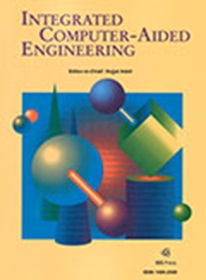Both Interdisciplinary and Interesting
IF 5.3
2区 计算机科学
Q1 COMPUTER SCIENCE, ARTIFICIAL INTELLIGENCE
引用次数: 0
Abstract
Sometimes all it takes to realize the significance of a thing is simply to understand its name. This is certainly the case for the journal Integrated ComputerAided Engineering (ICAE), which has now been benefitting interdisciplinary researchers for 30 years. The name ICAE starts with “integrated,” which speaks to the very interdisciplinary nature of the journal. ICAE is about research projects, not simple research papers. To publish in ICAE is to present research in a larger context, making ICAE articles of interest to researchers and enthusiasts in several technology fields at once. The second part of ICAE’s name is “computer,” and some elaboration is necessary here. ICAE papers are not about computer architecture or about computer networks; instead, ICAE is about using computer architectures and networks in optimal ways to solve technical problems. This comes to the third part of the four-part name: “aided”. Computing is used to aid technologists in their research and development challenges. Computing is a tool, and ICAE authors are expected to actually use their tools properly. If it’s a nail, you’d better use a hammer, but if it’s a screw, you’d better use a screwdriver. If a paper is submitted to ICAE, it had better not simply grab the latest convolutional neural network (CNN) design and apply it to a known data set and present its 2% reduction in error rate as a finding. That is simply a verification that CNN designs continue to incrementally improve, and as such is nothing more than a verification that CNNs continue to be useful tools for the technical community. Reaching back to the earlier analogy, that is tantamount to showing that the latest hammer will pound a nail with 2% more efficiency. Nice to know, but not interesting. Perhaps this is why the third part of the name of ICAE is so important. When one must use a tool to aid in a task, it should be an interesting task. For me, this is why ICAE is one of my favorite journals. It is both interdisciplinary and interesting. Incremental articles are not ICAE articles. Hojjat Adeli, the Founder and Editor-in-Chief of ICAE, makes this clear in the reviewer form for ICAE, which specifically asks “If you are aware of the authors’ other recent publications please explain how the current submission is different from their previous publication. Please point out the duplication, if any, and provide specific suggestions to minimize any duplication.” In other words, any duplication is grounds for constructive, but also restrictive, feedback to the authors. It is computer-aided, not computer-using, research. This brings us to the fourth part of the name, “engineering.” Engineers are applied researchers. They build devices, they test what they build, they create useful and reproducible outputs. We need only consider the next part of the reviewer feedback to see this need for building, testing, and utility: “Please comment whether examples presented in the paper are appropriate and justified considering the significant advances made in computational modeling in recent years as well as the increasing power of computers. Are the examples presented small academic exercises?” Sure, ICAE publishes papers from some of the world top academics; after all, that is precisely what its Editor-in-Chief is. However, ICAE requires these folks to build, test, and provide the “engineering blueprints” (that is, the ability to reproduce the results) of their research so the entire ICAE audience can benefit from the engineering insights of the authors. I am a professor in a Systems Engineering Department, which is a formal engineering discipline focused on integration. For me, the ICAE journal is an important element of staying aligned with the advancements in large, integrated engineering research. I have been a reviewer for ICAE for over a decade (much of that time as a Fellow at HP Labs, and more recently as a Professor at Colorado State University). I joined the Editorial Advisory Board a couple of years ago. ICAE has remained as relevant to me in my new career in academia as it was in my former career in the computing industry.既跨学科又有趣
有时候,要了解一件事物的重要性,只需要知道它的名字。《综合计算机辅助工程》(Integrated ComputerAided Engineering, ICAE)杂志的情况当然如此,30年来,跨学科研究人员一直从中受益。ICAE的名字以“综合”开头,这说明了该期刊的跨学科性质。ICAE是关于研究项目,而不是简单的研究论文。在ICAE上发表文章是为了在更大的背景下展示研究成果,使ICAE的文章同时引起几个技术领域的研究人员和爱好者的兴趣。ICAE名称的第二部分是“计算机”,这里需要详细说明。ICAE的论文不是关于计算机体系结构或计算机网络的;相反,ICAE是关于以最佳方式使用计算机体系结构和网络来解决技术问题。这是这个由四部分组成的名字的第三部分:“辅助”。计算机是用来帮助技术人员在他们的研究和开发挑战。计算是一种工具,ICAE的作者应该正确地使用他们的工具。如果是钉子,你最好用锤子,但如果是螺丝,你最好用螺丝刀。如果一篇论文提交给ICAE,它最好不要简单地抓住最新的卷积神经网络(CNN)设计,并将其应用于已知的数据集,并将其错误率降低2%作为发现。这只是证明CNN的设计在不断地改进,而这只不过是证明CNN仍然是技术社区有用的工具。回到之前的类比,这相当于表明最新的锤子将以2%的效率敲打钉子。很高兴知道,但并不有趣。也许这就是ICAE名称的第三部分如此重要的原因。当一个人必须使用工具来协助完成一项任务时,它应该是一项有趣的任务。对我来说,这就是为什么ICAE是我最喜欢的期刊之一。它既跨学科又有趣。增量文章不是ICAE文章。ICAE的创始人兼主编Hojjat Adeli在ICAE的审稿人表格中明确指出了这一点,其中特别要求“如果您知道作者最近发表的其他文章,请解释当前提交的文章与他们以前发表的文章有何不同。”如有重复,请指出,并提供具体建议,以尽量减少重复。”换句话说,任何复制都是建设性的,但也是限制性的,反馈给作者的理由。它是计算机辅助的,而不是使用计算机的研究。这就引出了这个名字的第四部分,“工程”。工程师是应用研究人员。他们制造设备,他们测试他们制造的东西,他们创造有用的和可重复的输出。我们只需要考虑审稿人反馈的下一部分,就可以看到构建、测试和实用的需求:“请评论一下,考虑到近年来在计算建模方面取得的重大进展,以及计算机日益增强的能力,论文中提出的例子是否合适和合理。”这些例子是小型的学术练习吗?”当然,ICAE发表了一些世界顶级学者的论文;毕竟,这正是它的总编辑。然而,ICAE要求这些人构建、测试并提供他们研究的“工程蓝图”(即重现结果的能力),这样整个ICAE的受众都可以从作者的工程见解中受益。我是系统工程系的一名教授,这是一门专注于集成的正式工程学科。对我来说,ICAE期刊是与大型综合工程研究进展保持一致的重要元素。我在ICAE做了十多年的审稿人(大部分时间是作为惠普实验室的研究员,最近是作为科罗拉多州立大学的教授)。几年前我加入了编辑顾问委员会。ICAE对我在学术界的新职业生涯和我以前在计算机行业的职业生涯一样重要。
本文章由计算机程序翻译,如有差异,请以英文原文为准。
求助全文
约1分钟内获得全文
求助全文
来源期刊

Integrated Computer-Aided Engineering
工程技术-工程:综合
CiteScore
9.90
自引率
21.50%
发文量
21
审稿时长
>12 weeks
期刊介绍:
Integrated Computer-Aided Engineering (ICAE) was founded in 1993. "Based on the premise that interdisciplinary thinking and synergistic collaboration of disciplines can solve complex problems, open new frontiers, and lead to true innovations and breakthroughs, the cornerstone of industrial competitiveness and advancement of the society" as noted in the inaugural issue of the journal.
The focus of ICAE is the integration of leading edge and emerging computer and information technologies for innovative solution of engineering problems. The journal fosters interdisciplinary research and presents a unique forum for innovative computer-aided engineering. It also publishes novel industrial applications of CAE, thus helping to bring new computational paradigms from research labs and classrooms to reality. Areas covered by the journal include (but are not limited to) artificial intelligence, advanced signal processing, biologically inspired computing, cognitive modeling, concurrent engineering, database management, distributed computing, evolutionary computing, fuzzy logic, genetic algorithms, geometric modeling, intelligent and adaptive systems, internet-based technologies, knowledge discovery and engineering, machine learning, mechatronics, mobile computing, multimedia technologies, networking, neural network computing, object-oriented systems, optimization and search, parallel processing, robotics virtual reality, and visualization techniques.
 求助内容:
求助内容: 应助结果提醒方式:
应助结果提醒方式:


